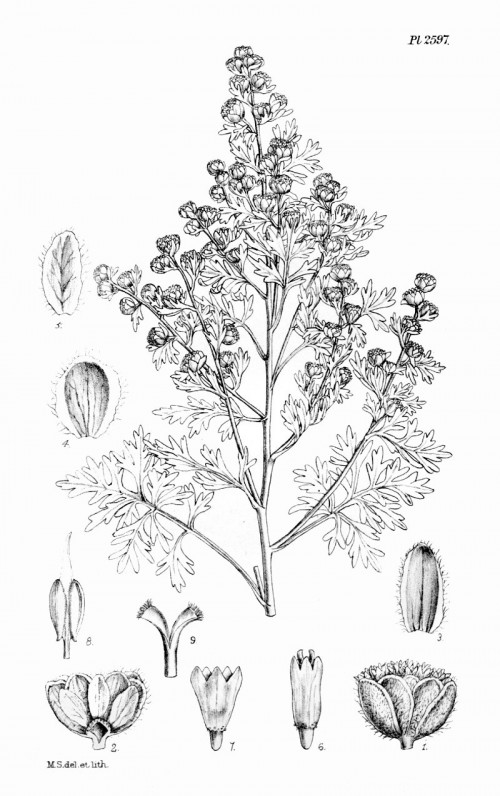Benutzer-Werkzeuge
Artemisia pallens Wall. ex DC. - Asteraceae - davanam (Tamil), davana, Fahlblättriger Beifuß
Fragrant herb, 30-120cm high, native to the southern part of India (Karnataka, Tamil Nadu, Andhra Pradesh, Maharashtra); leaves alternate, pinnatisect, bluish green; flowers numerous, yellow.
„Davana oil is used in making perfumes of sweet and fruity fragrances. When applied on the skin, Davana is said to smell differently on different persons. This peculiar property is highly valued in high class perfumery to create fragrances with truly individual notes. Davana leaves and stalks are used in making bouquets, garlands, fresh or dry flower arrangements.“ http://en.wikipedia.org/wiki/Artemisia_pallens
„The fragrance of the herb and its essential oil is described as deep, mellow, persistent and characteristically fruity…. In the late 1960's davana oil caught fancy of perfumers in USA and Europe. The newly launched perfume Idole d'Armani (Armani 2009) includes davana oil as a special note.“ http://www.bojensen.net/EssentialOilsEng/EssentialOils10/EssentialOils10.htm
Davana oil, the essential oil of A.pallens, contain more than 50 compounds. Main components are furanoid sesquiterpenes like (Z)-davanone (38%), (E)-davanone (5%), (E)-hydroxydavanone (2%) and (Z)-hydroxydavanone (3%), iso- and nor-davanone, davana ether, davana furan and davanol, together with nerolidol (10%) and cinnamyl cinnamate (2%).
[Fragrant components of oil from Artemisia pallens. Misra, L. N., Chandra, A., Thakur, R. S., Phytochemistry, Vol.30(2), 1991, 549-552]
„The influence of three plant growth stages (full emergence of flower heads, anthesis, and initiation of seed set) on the essential oil content and composition in Davana (Artemisia pallens Wall) was investigated over two successive seasons. The essential oil content was found to be higher at the full emergence of flower heads than at anthesis and initiation of seed set stages. The contents of davanone, the major constituent of davana oil, and linalool decreased while those of (Z)- and (E)-methyl cinnamate, (E)-ethyl cinnamate, bicyclogermacrene, davana ether, 2-hydroxyisodavanone, and farnesol increased from flower heads emergence stage to the initiation of seed set stage. These results support the general practice of harvesting the crop at full bloom stage. Five compounds, viz., (Z)- and (E)-methyl cinnamates, (Z)- and (E)-ethyl cinnamates, and geranyl acetate, were identified for the first time in davana oil.“
[Influence of plant growth stage on the essential oil content and composition in davana (Artemisia pallens Wall.). Mallavarapu, G. R., Kulkarni, R. N., Baskaran, K., Rao, L., Ramesh, S., Journal of agricultural and food chemistry, Vol.47(1), 1999, 254-258]
Davana oil, obtained by steam distillation of the herb of A.pallens, is an orange-brown liquid with a sweet tealike odor reminiscent of dried fruits.
[H. Surburg und J. Panten: Common Fragrance and Flavor Materials: preparation, properties, and uses. Wiley-VCH, Weinheim 2006, 204]
„The oil of davana is produced from dried davana plants by steam distillation with yields of approximately 0.2%. The oil is a brownish or dark greenish viscous liquid, very aromatic, with a persistent odor somewhat reminiscent of bourbon…
A number of important observations can be made from the olfactometry evaluation of the crude natural davana oil: (1) major components do not necessarily correlate with major sensory responses; (2) powerful sensory responses are observed for minor/trace constituents; (3) davanone with a value of 40 is not the major sensory component, yet it affords the greatest MS response; (4) eight other components had intensities greater than that of davanone; and (5) a number of powerful sensory components are essentially below TIC detection limits and, hence, remain unidentified at this time. In addition, all of the sensory attributes identified in the GC/O
analyses were positive in nature and could be described as fruity, spicy, musty, green, sweet, and pleasant. These olfactometry results are in agreement with the literature in that davanone has been reported to have little to no aroma. On the other hand, minor components are thought to contribute significantly to the aroma of davana oil.“
Fruit esters like 2-methylbutyl 2-methylbutyrate (4.5%), propyl 2-methylbutyrate (3.8%), propyl 3-methylbutyrate (3.0%) and pentyl 3-methylbutyrate (2.1%) as well as some cinnamates and furanones [5,5-dimethyl-2(5H)-furanone (1.6%), 5-ethenyldihydro-5-methyl-2(3H)-furanone (1.2%)] were found in the headspace above davana oil.
[Isomeric enhancement of davanone from natural davana oil aided by supercritical carbon dioxide., Coleman, W.M., Dube, M.F., Ashraf-Khorassani, M., Taylor, L.T., Journal of agricultural and food chemistry, 55(8), 2007, 3037-3043]

Hooker,W.J., Hooker,J.D., Icones Plantarum [Hooker’s] Icones plantarum], vol.26, t.2597 (1899) [M.Smith]
http://plantgenera.org/species.php?id_species=92499
